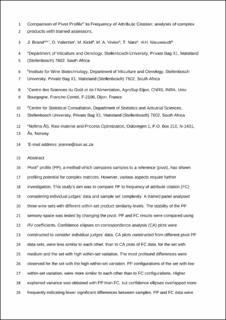| dc.contributor.author | Brand, Jeanne | |
| dc.contributor.author | Valentin, Dominique | |
| dc.contributor.author | Kidd, Martin | |
| dc.contributor.author | Vivier, Melane A. | |
| dc.contributor.author | Næs, Tormod | |
| dc.contributor.author | Nieuwoudt, Helene H. | |
| dc.date.accessioned | 2020-12-10T12:09:20Z | |
| dc.date.available | 2020-12-10T12:09:20Z | |
| dc.date.created | 2020-07-27T10:40:50Z | |
| dc.date.issued | 2020 | |
| dc.identifier.citation | Food Quality and Preference. 2020, 84 . | en_US |
| dc.identifier.issn | 0950-3293 | |
| dc.identifier.uri | https://hdl.handle.net/11250/2716925 | |
| dc.description.abstract | Pivot© profile (PP), a method which compares samples to a reference (pivot), has shown profiling potential for complex matrices. However, various aspects require further investigation. This study’s aim was to compare PP to frequency of attribute citation (FC) considering individual judges’ data and sample set complexity. A trained panel analysed three wine sets with different within-set product similarity levels. The stability of the PP sensory space was tested by changing the pivot. PP and FC results were compared using RV coefficients. Confidence ellipses on correspondence analysis (CA) plots were constructed to consider individual judges’ data. CA plots constructed from different pivot PP data sets, were less similar to each other, than to CA plots of FC data, for the set with medium and the set with high within-set variation. The most profound differences were observed for the set with the high within-set variation. PP configurations of the set with low within-set variation, were more similar to each other than to FC configurations. Higher explained variance was obtained with PP than FC, but confidence ellipses overlapped more frequently indicating fewer significant differences between samples. PP and FC data were comparable for the set with medium within-set variation. From this study’s results PP is recommended for wine profiling if medium within-set variation between samples exist but not when sample sets with low or high within-set variation are profiled. PP is recommended over FC for comparative studies where a reference sample is required for example during benchmarking or for aging and shelf-life studies. | |
| dc.language.iso | eng | en_US |
| dc.subject | Frequency of attribute citation | |
| dc.subject | Frequency of attribute citation | |
| dc.subject | Pivot profile | |
| dc.subject | Pivot profile | |
| dc.subject | CATA | |
| dc.subject | CATA | |
| dc.title | Comparison of pivot profile© to frequency of attribute citation: Analysis of complex products with trained assessors | en_US |
| dc.type | Peer reviewed | en_US |
| dc.type | Journal article | en_US |
| dc.description.version | acceptedVersion | |
| dc.source.pagenumber | 16 | en_US |
| dc.source.volume | 84 | en_US |
| dc.source.journal | Food Quality and Preference | en_US |
| dc.identifier.doi | 10.1016/j.foodqual.2020.103921 | |
| dc.identifier.cristin | 1820566 | |
| dc.relation.project | Norges forskningsråd: 262308 | |
| cristin.ispublished | true | |
| cristin.fulltext | postprint | |
| cristin.qualitycode | 1 | |
